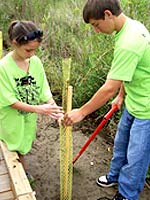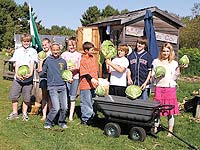Society faces pressing problems on many fronts today. Economic crises mean more families require assistance to meet basic needs, environmental degradation contributes to natural disasters, and disparities in educational opportunities leave some communities at risk.
Luckily, some of the best minds in our nation are in our midst, tackling these issues and more. You’ll find these change agents in middle schools across the United States: students learning science, history, economics, and language arts as they accomplish important work for their communities.
Many of these students are in schools that are part of the National Youth Leadership Council’s growing Generator School Network, a community of schools where teachers and administrators have committed to integrating the powerful pedagogy of service-learning across disciplines as a way to enliven learning.
For example, students at Troy Howard Middle School in Belfast, Maine, tackle both hunger and environmental concerns, growing fresh produce for a local food bank. What began as a relatively simple garden project, designed to save land from becoming a bus parking lot, has developed into an important local resource.
On little more than an acre, students last year grew more than three tons of produce, according to teachers Steven Tanguay and Jon Thurston. The garden has become a real-world learning lab for students to investigate such diverse topics as poverty and hunger, soil composition, greenhouse temperature control, wholesale vs. retail pricing, watersheds, and local history.

Throughout the school year, students plan and conduct water quality monitoring, collecting and identifying macro-invertebrates, cleaning up litter, identifying soil and plants, and planting trees.
At Harry Hurst Middle School in Destrehan, Louisiana, students drive an effort to preserve the state’s wetlands. Through the LaBranche Wetland Watchers service-learning project, science teacher Barry Guillot and his team of educators work with 1,100 students each school year in grades 5–7 on service trips to their adopted wetland site in the Bonnet Carre Spillway.
Throughout the school year, students plan and conduct water quality monitoring, collecting and identifying macro-invertebrates, cleaning up litter, identifying soil and plants, and planting trees. Each year, students choose to focus on something new for the project. For example, last year, they worked to initiate the first public nature trail in the region. Students educate other students and adults in their community about what they’ve learned about wetland conservation in their investigations, reaching nearly 50,000 people to date.
Sixth graders at the Barack and Michelle Obama Service-Learning Academy in St. Paul, Minnesota, tackled two of the weightiest issues in education: early literacy development and improving access to postsecondary education. As part of National Literacy Week, students investigated how young children learn to read and then partnered with a local bookstore to put together baskets of information and resources for low-income families with children ages 1–4.
According to teacher Tiffany Berg, upon learning how few of the students in their neighborhood go on to postsecondary education, the sixth graders investigated ways to make college more accessible, interviewing panels of students and teachers from a variety of local postsecondary institutions and then putting together a community presentation about what they learned.
A New Look at Education
The stories of the contributions young people are making to our world provide the evidence we need to advocate for a different kind of school, a new way of teaching, and a new way of learning that can help students succeed and communities prosper.
Education isn’t necessarily only about the future and what young people will accomplish when they grow up, it is also about what they are capable of doing now with the knowledge and skills they possess. Like the students from the Generator Schools, young people across the United States and around the world are showing us the way.
But beyond these inspiring examples, research, too, shows that high-quality service-learning can have quantifiable, positive impacts on students. It can increase academic performance, civic engagement and responsibility, and personal and social development. (For a summary of this research, visit www.nylc.org/g2g)
We know from researchers such as Constance Flanagan of Pennsylvania State University that the middle grades years are a turning point for young people as they begin to make the transition to adulthood. We know that the seeds of disengaging from school and dropping out before graduation take root during this period.
John Bridgeland of Civic Enterprises and other research, including NYLC research conducted by Harris Interactive (The Impact of Service-Learning on Transitions to Adulthood), found that service-learning is a strategy for engaged learning that has proven successful among the most disengaged students and least successful schools, particularly those in urban communities. Service-learning can play a significant role in school improvement if infused and advanced in these communities.
Landmark bipartisan legislation passed this year in the first 100 days of President Obama’s administration offers hope for this new kind of schools and learning. The service provisions of the Edward M. Kennedy Serve America Act, involving a new infusion of AmeriCorps members, have been well-publicized. But the law goes beyond a larger AmeriCorps role. It encourages high-quality service-learning practice and curriculum that is rooted in evidence-based standards.
Unlike AmeriCorps, an independent, government-funded service program, the relatively small Learn and Serve America area of the Corporation for National and Community Service has a catalytic role to stimulate partnerships with schools and higher education to help advance a much larger service-learning movement.
Setting the Standard
The President’s explicit focus on quality practice is groundbreaking. In Obama’s service agenda, he cites the need to “develop national guidelines for service-learning and give schools better tools both to develop programs and to document student experience.” The K–12 Service-Learning Standards for Quality Practice, published last spring by NYLC in cooperation with the Corporation for National and Community Service, meet this need.
| K-12 Service-Learning Standards for Quality Practice |
For a downloadable copy of the standards and their accompanying indicators of quality, visit www.nylc.org/standards |
These quality standards are the result of many years of effort in the field. NYLC worked with many stakeholders—academics, researchers, K–12 educators, school administrators, education policymakers, service-learning practitioners, and young people—to develop new evidence-based standards to improve K–12 service-learning.
Funding from State Farm Companies Foundation allowed us to engage respected researchers to delve into what the evidence shows about which elements are essential to effective service-learning. Standards based on this evidence were drafted by expert practitioners and then fine-tuned by panels of stakeholders across the country. The resulting eight standards (see below) have since been widely adopted by service-learning and education organizations nationally and internationally as a way to ensure that service-learning is rigorously enacted.
The push for accountability, outcomes, and evidence is welcomed by the service-learning movement as we seek to demonstrate measurable results in education. Increasingly, service-learning practitioners demonstrate credible academic evaluation principles and practices as we look critically at how young people learn best.
Call to Action
President Obama has called for more volunteer service across the generational spectrum. In the rush to respond with immediacy—a laudable American tendency—we must publicize individual acts of charity and look toward a citizen-investment strategy. Research shows that engaged service by middle grades students, especially through school-sponsored service-learning, imprints a pattern of contribution leading to a lifetime of engaged citizenship and active learning. Add to these benefits the results of well-designed service-learning on academic achievement and dropout prevention and the argument for service-learning is bolstered further.
More than a third of all public middle schools have some form of service-learning. Some, like members of the burgeoning Generator School Network, are invested in high-quality practice across the curriculum and are seeing amazing results—especially among our least engaged students. Service-learning extends the idea of cocurricular volunteerism into a progressive education model harkening back to the work of John Dewey, Maria Montessori, and James Coleman. Service-learning done well is simply good teaching and learning!
